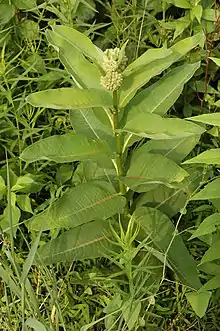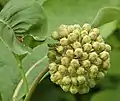Asclepias syriaca
Asclepias syriaca, commonly called common milkweed, butterfly flower, silkweed, silky swallow-wort, and Virginia silkweed, is a species of flowering plant. It is in the genus Asclepias, the milkweeds. It is native to southern Canada and much of the United States east of the Rocky Mountains, excluding the drier parts of the prairies.[1] It grows in sandy soils as well as other kinds of soils in sunny areas.
| Asclepias syriaca | |
|---|---|
 | |
| Scientific classification | |
| Kingdom: | Plantae |
| Clade: | Tracheophytes |
| Clade: | Angiosperms |
| Clade: | Eudicots |
| Clade: | Asterids |
| Order: | Gentianales |
| Family: | Apocynaceae |
| Genus: | Asclepias |
| Species: | A. syriaca |
| Binomial name | |
| Asclepias syriaca | |
Description
Common milkweed is a clonal perennial herb growing up to 1.8 m (5 ft 11 in) tall.[2] Individual plants grow from rhizomes. All parts of common milkweed plants produce a white latex when cut. The simple leaves are opposite, sometimes whorled; broadly ovate-lanceolate. They grow to 10–28 cm (4–11 in) long and 4–12 cm (1 1⁄2–4 3⁄4 in) broad,[2] usually with entire, undulate margins and reddish main veins. They have very short petioles and velvety undersides.
The highly fragrant, nectariferous flowers vary from white (rarely) through pinkish and purplish and occur in umbellate cymes.[3][4] Individual flowers are about 1 cm (0.4 in) in diameter, each with five horn-like hoods and five pollinia. The seeds, each with long, white flossy hairs, occur in large follicles. Fruit production from self-fertilization is rare. In three study plots, outcrossed flowers had an average of about 11% fruit set.[5]
Ecology
More than 450 insects species feed on Asclepias syriaca, including flies, beetles, ants, bees, wasps, and butterflies; it is an important food source for monarch butterfly caterpillars (Danaus plexippus); other species that feed on the plant include red milkweed beetle (Tetraopes tetraophthalmus), the milkweed tussock caterpillar (Euchaetes egle) and Oncopeltus fasciatus and Lygaeus kalmia.[6] Many kinds of insects visit A. syriaca flowers, and some kinds pollinate them, including Apis mellifera, the Western honey bee, and native Bombus spp. (bumblebees). In the U.S. mid-Atlantic region, the introduced species A. mellifera was found to be the most "effective" pollinator, but this occurs more often among flowers of the same plant; since A. syriaca has a high level of self-incompatibility, it is less effective than 'Bombus spp. in the fertilization of flowers because Bombus spp. are more likely to visit unrelated individuals.[7]
Monarch butterfly larvae consume only milkweeds, and monarch populations may decline when milkweeds are eliminated with herbicides.[8] The development and widely adopted cultivation of herbicide-resistant staple crops such as corn and soybeans have led to a massive reduction in weeds and native plants such as milkweeds.[9] Subsequently, this has played a significant part in the population decline of the monarch butterfly. In 2018 the CEO of the National Wildlife Federation stated that the population of the monarch butterfly is now down 90 percent in the last 20 years and cited the reduction in milkweed as a contributing factor.[10]
Many parts of the United States face a reduction in milkweed population due to factors such as increased habitat loss due to development, roadside median mowing, and herbicide use. Despite this, deforestation due to human settlement may have expanded the range and density of common milkweed in some regions. Milkweed has even become invasive as it is naturalized in several areas outside of its original native range, including Oregon and some parts of Europe.
Cultivation
Asclepias syriaca can be weedy or invasive.[1] It spreads aggressively and may not be suited to small gardens and formalized plantings.[11] Common milkweed is winter hardy in USDA zones 3-9; it has a preference for moist but well drained soils, but is tolerant of dry conditions and clay soils.[12]
Monarch Watch provides information on rearing monarchs and their host plants.[13] Efforts to increase butterfly populations by establishing butterfly gardens and monarch migratory "waystations" require particular attention to the target species' food preferences and population cycles, as well to the conditions needed to propagate their food plants.[14][15]
In the northeastern United States, monarch reproduction peaks in late summer when most of the plant's leaves are old and tough; plants that are cut back in June – August regrow rapidly from their rhizomes.,[15] in time for monarch egg-laying, during which time female monarchs have a preference for A. syriaca whose foliage is more succulent.[16]
A. syriaca is easily propagated by both seed and rhizome cuttings.[15] The plant's seeds require a period of cold treatment (cold stratification) before they will germinate.[17][14][15][18] Both seedlings and cuttings will usually bloom in their second year, although cuttings will occasionally bloom during their first year.[15] The plant increases by underground shoots and can be invasive. It is ideal in semi-dry places where it can spread without presenting problems for other ornamental species.[15]
The nonnative Aphis nerii (oleander aphid) can become abundant on milkweed shoots.[16]
Uses
The plant's latex contains large quantities of glycosides, making the leaves and follicles (often called "seed pods", although they are not botanical pods) toxic to sheep and other large mammals, and, potentially, humans (though large quantities of the foul-tasting parts would need to be eaten). The young shoots, young leaves, flower buds and immature fruits are all edible raw.[19]
The notion that milkweed is bitter and toxic may have originated with Euell Gibbons, author of Stalking the Wild Asparagus (1962), he may have inadvertently prepared common dogbane (Apocynum cannabinum), a poisonous somewhat similar-looking plant instead. He devised a method to remove the bitterness and toxicity by plunging the young shoots into boiling water and cooking for one minute, repeating the procedure at least three times to make the plant safe to eat. Gibbons' method was copied from book to book, dominating edible plants literature for forty years. Most modern foragers consider the bitterness and toxicity issue a myth. The plants have no bitterness when tasted raw, and can be cooked like asparagus, with no special processing.[19]
Failed attempts have been made to exploit rubber (from the latex) and fiber (from seeds' "floss") production from the plant industrially. The fluffy seed hairs have been used as the traditional background for mounted butterflies and other insects. The compressed floss has a silk-like sheen. The plant has also been explored for commercial use of its bast (inner bark) fiber, which is both strong and soft. U. S. Department of Agriculture studies in the 1890s and 1940s found that common milkweed has more potential for commercial processing than any other indigenous bast fiber plant, with estimated yields as high as hemp and quality as good as flax. Both the bast fiber and the floss were used historically by Native Americans for cordage and textiles. Milkweed has also been cultivated commercially to be used as insulation in winter coats.[20]
Gallery
 Buds in an umbelate cyme
Buds in an umbelate cyme.jpg.webp) Flowers
Flowers Follicle
Follicle Seeds emerging from a follicle
Seeds emerging from a follicle Seeds
Seeds
Notes
- "Plants Profile for Asclepias syriaca (common milkweed)". plants.usda.gov. Retrieved January 2, 2021.
- Elias, Thomas S.; Dykeman, Peter A. (2009) [1982]. Edible Wild Plants: A North American Field Guide to Over 200 Natural Foods. New York: Sterling. p. 106. ISBN 978-1-4027-6715-9. OCLC 244766414.
- Liede, Sigrid; Weberling, Focko (1995). "On the inflorescence structure of Asclepiadaceae". Plant Systematics and Evolution. 197 (1–4): 99–109. doi:10.1007/BF00984635. JSTOR 23642939. S2CID 28917929.
- Lawrence, George H. M (1951). Taxonomy of vascular plants. Macmillan. OCLC 1151341689.
- Sparrow, F. K.; Pearson, N. L. (1948). "Pollen compatibility in Asclepias syriaca". Journal of Agricultural Research. 77: 187–199.
- "Common Milkweed". www.fs.fed.us. Retrieved January 6, 2021.
- Howard, Aaron F; Barrows, Edward M (2014). "Self-pollination rate and floral-display size in Asclepias syriaca (Common Milkweed) with regard to floral-visitor taxa". BMC Evolutionary Biology. 14 (1): 144. doi:10.1186/1471-2148-14-144. PMC 4080991. PMID 24958132.
- Pleasants, John M.; Oberhauser, Karen S. (March 2013). "Milkweed loss in agricultural fields because of herbicide use: effect on the monarch butterfly population: Herbicide use and monarch butterflies". Insect Conservation and Diversity. 6 (2): 135–144. doi:10.1111/j.1752-4598.2012.00196.x. S2CID 14595378.
- Arnold, Carrie (December 21, 2018). "We're losing monarchs fast—here's why". National Geographic.
- "Monarch Butterfly 2018 Population Down by 14.8 Percent". The National Wildlife Federation Blog. March 7, 2018. Retrieved January 2, 2021.
- Hayes, Rhonda Fleming (2016). "A Milkweed for Every Garden". Pollinator Friendly Gardening: Gardening for Bees, Butterflies, and Other Pollinators. Voyageur Press. p. 88. ISBN 978-0-7603-4913-7.
- "Common milkweed". The Morton Arboretum. Retrieved January 5, 2021.
- Jim Lovett. "Monarch Watch". monarchwatch.org. Retrieved September 27, 2015.
- Gomez, Tony. "Asclepias syriaca: Common Milkweed for Monarch Caterpillars". Monarch Butterfly Garden. Archived from the original on March 16, 2015.
- "Common Milkweed: Asclepias syriaca L." (PDF). Plant Guide. United States Department of Agriculture: Natural Resources Conservation Service. Retrieved May 29, 2015. Archived March 27, 2015, at the Wayback Machine
- Higgins, Adrian (May 27, 2015). "A gardener's guide to saving the monarch". Home & Garden. The Washington Post. Archived from the original on September 26, 2020.
- Higgins, Adrian (May 27, 2015). "7 milkweed varieties and where to find them". Home & Garden. The Washington Post. Archived from the original on September 26, 2020.
- "Asclepias syriaca". Butterfly gardening & all things milkweed. Retrieved July 7, 2015.
germination: seed requires cold moist period
Archived July 7, 2015, at the Wayback Machine. - Thayer, S. (2006). The Forager's Harvest. Forager's Harvest. pp. 290–305. ISBN 0-9766266-0-8.
- Bernstein, Jaela (October 13, 2016). "How a Quebec company used a weed to create a one-of-a-kind winter coat". CBC News. Retrieved January 5, 2018.
References
- Lamoureux, G.; et al. (1978). Plantes sauvages des villes et des champs. Fleurbec/Éditeur officiel du Québec. ISBN 2-920174-00-2.
- Lamoureux, G.; et al. (1981). Plantes sauvages comestibles. Fleurbec. ISBN 2-920174-03-7.
- Brother Marie-Victorin (1975). Flore Laurentienne. Les Presses de l'Université de Montréal. ISBN 0-8405-0018-1.
- Buchanan, R. (1987). A Weaver's Garden. Interweave Press, Inc. ISBN 0-934026-28-9.
External links
![]() Media related to Asclepias syriaca at Wikimedia Commons
Media related to Asclepias syriaca at Wikimedia Commons
